Beko RFNE290T45XPN User Manual

Freezer
User manual
Gefrierschrank
Bedienungsanleitung
Congélateur
Manueld'utilisation
Diepvriezer
Gebruiksaanwijzing
RFNE290T45XPN
EN / DE / FR / NL
58 5101 0000/AA
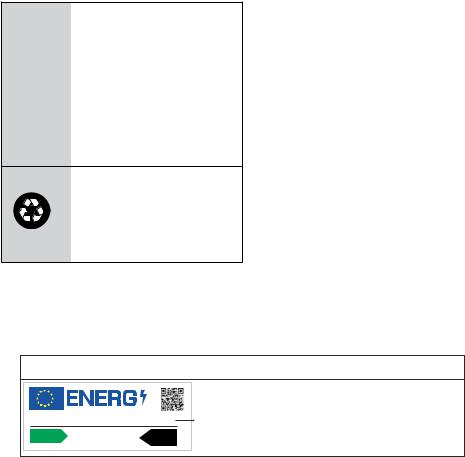
Please read this manual before using the product!
Dear Customer,
We'd like you to make the best use of our product, which has been manufactured in modern facilities with care and meticulous quality controls.
Thus, we advice you to read the entire user manual before you use the product. In case the product changes hands, do not forget to hand the guide to its new owner along with the product.
This guide will help you use the product quickly and safely.
t Please read the user guide carefully before installing and operating the product. t Always observe the applicable safety instructions.
t Keep the user guide within easy reach for future use.
t Please read any other documents provided with the product.
Keep in mind that this user guide may apply to several product models. The guide clearly indicates any variations of different models.
C |
Important information and |
useful tips. |
|
|
|
A |
Risk of life and property. |
|
|
B |
Risk of electric shock. |
The product’s packaging is made of recyclable materials, in accordance with the National Environment Legislation.
C INFORMATION |
|
|
|
|
|
The model information as stored in the product data |
base |
|
|
can be reached by entering following website and searching |
|
|
|
for your model identifier (*) found on energy label. |
|
SUPPLIER’S NAME |
MODEL IDENTIFIER |
(*) |
|
A |
A |
https://eprel.ec.europa.eu/ |
|
|
|
||
|
|
|
|

1.Safety and environment |
|
instructions4 |
|
General safety ............................................... |
4 |
Intended use .................................................. |
6 |
Child safety ..................................................... |
6 |
Compliance with WEEE Directive and |
|
Disposing of the Waste Product ............. |
7 |
Compliance with RoHS Directive............. |
7 |
Package information .................................... |
7 |
2 Your Freezer |
8 |
3 Installation |
9 |
Appropriate installation location ........... |
9 |
Installing the plastic wedges ................ |
10 |
Adjusting the feet ...................................... |
10 |
Electrical connection ................................ |
10 |
4 Preparation |
11 |
5 Operating the product |
12 |
Ice Pack .......................................................... |
13 |
Freezing fresh food ................................... |
14 |
Recommendations for preserving the |
|
frozen food.................................................... |
15 |
Deep-freeze information ........................ |
15 |
Placing the food .......................................... |
16 |
Freezing of Foodstuff............................... |
16 |
Door open warning .................................... |
16 |
Changing the door opening direction 16 |
|
6 Maintenance and cleaning 17 |
|
7 Troubleshooting |
18 |
Refrigerator/User Manual |
3 / 20 EN |
|
|
|
|
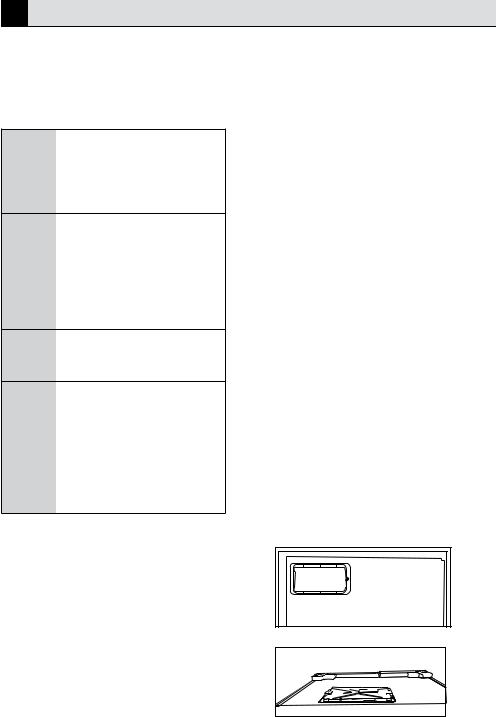
1. |
Safety and environment instructions |
||||||
This section provides the safety |
1.1. General safety |
||||||
instructions necessary to prevent the risk |
t |
This product should not be used by |
|||||
of injury and material damage. Failure to |
|
persons with physical, sensory and |
|||||
observe these instructions will invalidate |
|
mental disabilities, without sufficient |
|||||
all types of product warranty. |
|
|
knowledge and experience or by |
||||
Intended use |
|
|
|
|
children. The device can only be used |
||
|
WARNING: |
|
|
|
by such persons under supervision |
||
|
Keep ventilation openings, |
|
and instruction of a person |
||||
A in the appliance enclosure |
|
responsible for their safety. Children |
|||||
|
or in the built-instructure, |
|
should not be allowed to play with |
||||
|
clear of obstruction. |
|
|
this device. |
|||
|
WARNING: |
|
|
t |
In case of malfunction, unplug the |
||
|
Do not use mechanical |
|
|
device. |
|||
|
|
t |
After unplugging, wait at least 5 |
||||
|
devices or other means to |
||||||
|
|
minutes before plugging in again. |
|||||
A accelerate |
the |
defrosting |
|
||||
t |
Unplug the product when not in use. |
||||||
|
process, other than those |
t |
Do not touch the plug with wet |
||||
|
recommended |
by |
the |
||||
|
|
hands! Do not pull the cable to plug |
|||||
|
manufacturer. |
|
|
|
|||
|
|
|
|
off, always hold the plug. |
|||
|
WARNING: |
|
|
|
|||
A |
|
|
t |
Do not plug in the refrigerator if the |
|||
Do |
not |
damage |
the |
|
socket is loose. |
||
|
refrigerant circuit. |
|
t |
Unplug the product during |
|||
|
WARNING: |
|
|
|
installation, maintenance, cleaning |
||
|
Do |
not |
use |
electrical |
|
and repair. |
|
|
appliances inside the food |
t |
If the product will not be used for |
||||
|
storage |
compartments |
|
a while, unplug the product and |
|||
A of the appliance, unless |
|
remove any food inside. |
|||||
|
they are of the type |
t |
Do not use the product when the |
||||
|
recommended |
by |
the |
|
compartment with circuit cards |
||
|
manufacturer. |
|
|
|
located on the upper back part of the |
||
|
|
|
|
|
|
|
product (electrical card box cover) (1) |
This appliance is intended to be used in |
|
is open. |
|||||
household and similar applications such |
|
1 |
|||||
as |
|
|
|
|
|
|
|
– staff kitchen areas in shops, offices |
|
|
|||||
and other working environments; |
|
|
|
||||
– farm houses and by clients in hotels, |
|
|
|||||
motels and other residential type |
|
|
|||||
environments; |
|
|
|
|
|
|
|
– bed and breakfast type environments; |
|
1 |
|||||
– catering and similar non-retail |
|
||||||
applications. |
|
|
|
|
t |
|
|
|
|
|
|
|
|
|
|
|
4 /20 EN |
Refrigerator/User Manual |
|
|
|
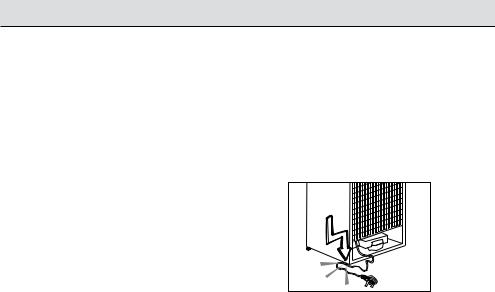
Safety and environment instructions
t Do not use steam or steamed cleaning materials for cleaning the refrigerator and melting the ice inside. Steam may contact the electrified areas and cause short circuit or electric shock!
t Do not wash the product by spraying or pouring water on it! Danger of electric shock!
t In case of malfunction, do not use the product, as it may cause electric shock. Contact the authorised service before doing anything.
t Plug the product into an earthed socket. Earthing must be done by a qualified electrician.
t If the product has LED type lighting, contact the authorised service for replacing or in case of any problem.
t Do not touch frozen food with wet hands! It may adhere to your hands!
t Do not place liquids in bottles and cans into the freezer compartment. They may explode.
t Place liquids in upright position after tightly closing the lid.
t Do not spray flammable substances near the product, as it may burn or explode.
t Do not keep flammable materials and products with flammable gas (sprays, etc.) in the refrigerator.
t Do not place containers holding liquids on top of the product. Splashing water on an electrified part may cause electric shock and risk of fire.
t Exposing the product to rain, snow, sunlight and wind will cause electrical danger. When relocating the product, do not pull by holding the door handle. The handle may come off.
t Take care to avoid trapping any part of your hands or body in any of the moving parts inside the product.
t Do not step or lean on the door, drawers and similar parts of the refrigerator. This will cause the product to fall down and cause damage to the parts.
t Take care not to trap the power cable.
t When positioning the appliance, ensure the supply cord is not trapped or damaged.
t Do not locate multiple portable socket-outlets or portable power supplies at the rear of the appliance.
t Children aged from 3 to 8 years are allowed to load and unload refrigerating appliances.
t To avoid contamination of food, please respect the following instructions:
t Opening the door for long periods can cause a significant increase of the temperature in the
t compartments of the appliance. t Clean regularly surfaces that can come in contact with food and accessible drainage systems.
t Clean water tanks if they have not been used for 48 h; flush the water system connected to a water
t supply if water has not been drawn for 5 days.
Refrigerator/User Manual |
5 / 20 EN |
|
|
|
|

Safety and environment instructions
|
t Store raw meat and fish in suitable |
|
are not sure that there is no water |
|||||
|
|
hammer effect in your installation. |
||||||
|
containers in the refrigerator, so that |
|
||||||
|
t |
Do not install on the hot water inlet. |
||||||
|
it is not in contact with or drip onto |
|||||||
|
|
Take precautions against of the |
||||||
|
other food. |
|
|
|
|
|||
|
|
|
|
|
risk of freezing of the hoses. Water |
|||
|
t Two-star frozen-food compartments |
|
||||||
|
|
temperature operating interval shall |
||||||
|
are suitable for storing pre-frozen |
|
|
|
||||
|
|
|
|
be 33°F (0.6°C) minimum and 100°F |
||||
|
food, storing or making icecream and |
|
||||||
|
|
(38°C) maximum. |
||||||
|
making ice cubes. |
|
|
|
|
|||
|
|
|
|
t |
Use drinking water only. |
|||
|
t One-, twoand three-star |
|
|
|||||
|
compartments are not suitable for |
|
|
1.2.Intended use |
||||
|
the freezing of fresh food. |
|
|
t |
This product is designed for home |
|||
|
t If the refrigerating appliance is left |
|||||||
|
|
use. It is not intended for commercial |
||||||
|
empty for long periods, switch off, |
|
|
|
||||
|
|
|
|
use. |
||||
|
defrost, clean, dry, and leave the door |
|
||||||
|
t |
The product should be used to store |
||||||
|
open to prevent mould developing |
|
|
|||||
|
|
|
|
food and beverages only. |
||||
|
within the appliance. |
|
|
|
||||
|
|
|
t |
Do not keep sensitive products |
||||
|
1.1.1 HC warning |
|
|
|
requiring controlled temperatures |
|||
|
If the product comprises a cooling |
|
(vaccines, heat sensitive medication, |
|||||
|
|
medical supplies, etc.) in the |
||||||
|
system using R600a gas, take care to |
|
||||||
|
|
refrigerator. |
||||||
|
avoid damaging the cooling system and |
|
||||||
|
t |
The manufacturer assumes no |
||||||
|
its pipe while using |
and moving |
the |
|||||
|
|
responsibility for any damage due to |
||||||
|
product. This gas is |
flammable. If |
the |
|
||||
|
|
misuse or mishandling. |
||||||
|
cooling system is damaged, keep the |
|
||||||
|
t |
Original spare parts will be provided |
||||||
|
product away from sources of fire and |
|||||||
|
|
for 10 years, following the product |
||||||
|
ventilate the room immediately. |
|
|
|
||||
|
|
|
|
purchasing date. |
||||
|
C |
The label on the inner left |
|
|
||||
|
|
1.3.Child safety |
||||||
|
side indicates the type of |
|
||||||
|
gas used in the product. |
|
|
t |
Keep packaging materials out of |
|||
|
1.1.2 For models with |
|
|
|
children’s reach. |
|||
|
|
|
t |
Do not allow the children to play with |
||||
|
water dispenser |
|
|
|||||
|
|
|
|
the product. |
||||
|
t Pressure for cold water inlet shall |
|
|
t |
If the product’s door comprises a lock, |
|||
|
be maximum 90 psi (620 kPa). If |
|
|
|
keep the key out of children’s reach. |
|||
|
your water pressure exceeds 80 psi |
|
|
|
||||
|
(550 kPa), use a pressure limiting |
|
|
|
|
|
||
|
valve in your mains system. If you |
|
|
|
|
|
||
|
do not know how to check your |
|
|
|
|
|
||
|
water pressure, ask for the help of a |
|
|
|
||||
|
professional plumber. |
|
|
|
|
|
||
|
t If there is risk of water hammer |
|
|
|
|
|
||
|
effect in your installation, always |
|
|
|
|
|
||
|
use a water hammer prevention |
|
|
|
|
|
||
|
equipment in your installation. |
|
|
|
|
|
||
|
Consult Professional plumbers if you |
|
|
Refrigerator/User Manual |
||||
|
|
|
6 /20 EN |
|
||||
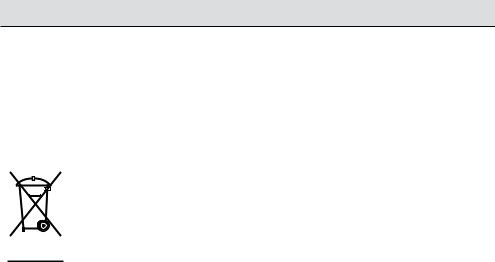
Safety and environment instructions
1.4. Compliance with WEEE Directive and Disposing
of the Waste Product
This product complies with EU WEEE Directive (2012/19/EU). This product bears a classification symbol for waste electrical and electronic equipment (WEEE).
This product has been
manufactured with high quality parts and materials which can be reused and are suitable for recycling. Do not

 dispose of the waste product with normal domestic and other wastes at the end of its service life.
dispose of the waste product with normal domestic and other wastes at the end of its service life.
Take it to the collection center for the recycling of electrical and electronic equipment. Please consult your local authorities to learn about these collection centers.
1.5.Compliance with
RoHS Directive
t This product complies with EU WEEE Directive (2011/65/EU). It does
not contain harmful and prohibited materials specified in the Directive.
1.6.Package information
Packaging materials of the product are manufactured from recyclable materials in accordance with our National Environment Regulations. Do not dispose of the packaging materials together with the domestic or other wastes. Take them to the packaging material collection points designated by the local authorities.
Refrigerator/User Manual |
7 / 20 EN |
|
|
|
|
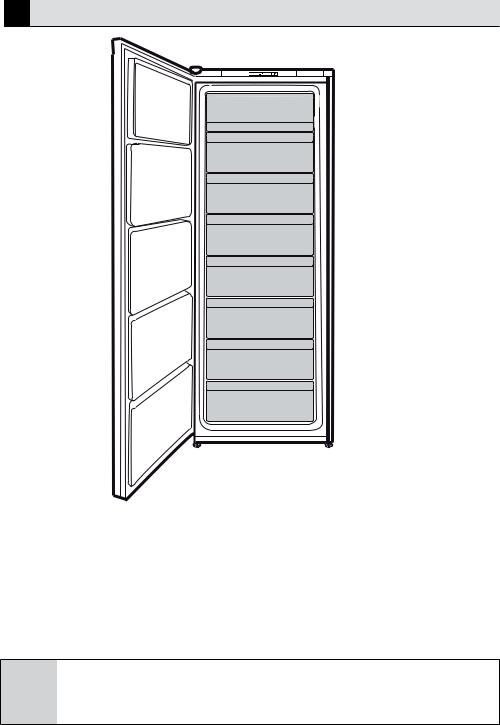
2 Your Freezer
1



2
3
|
* |
|
4 |
|
Control Panel |
|
Flap |
|
Drawers |
|
Adjustable front feet |
*May not be available in all models
Figures that take place in this instruction manual are schematic and C may not correspond exactly with your product. If the subject parts are
not included in the product you have purchased, then it is valid for other models.
|
8 /20 EN |
Refrigerator/User Manual |
|
|
|

3Installation
3.1.Appropriate installation location
Contact an Authorized Service for the installation of the product. In order to prepare the product for use, refer the information in the user manual and ensure that electrical installation and water installation are appropriate. If not, call a qualified electrician and technician to have any necessary arrangements carried out.
8"3/*/( Manufacturer shall not be held liable for damages
B that may arise from procedures carried out by unauthorized persons.
WARNING Product must not be plugged in during
B installation. Otherwise, there is the risk of death or serious injury!
WARNING:
If the door clearance of the room where the product shall be place is so tight to prevent
A passing of the product, remove the door of the room and pass the product through the door by turning it to its side; if this does not work, contact the authorized service.
t 1MBDF UIF QSPEVDU PO BO FWFO GMPPS surface to prevent jolts.
t *OTUBMM UIF QSPEVDU BU MFBTU DN away from heat sources such as hobs, heater cores and stoves and at least 5 cm away from electrical ovens.
t 1SPEVDU NVTU OPU CF TVCKFDUFE UP direct sun light and kept in humid places.
t "QQSPQSJBUF BJS WFOUJMBUJPO NVTU CF provided around your product in order to achieve an efficient operation. If the product is to be placed in a recess in the wall, pay attention to leave at least 5 cm distance with the ceiling and side walls.
t Your product requires adequate air circulation to function efficiently. If the product will be placed in an
alcove, remember to leave at least 5 cm clearance between the product and the ceiling, rear wall and the side walls.
t If the product will be placed in an alcove, remember to leave at least 5 cm clearance between the product and the ceiling, rear wall and the side walls. Check if the rear wall clearance protection component is present at its location (if provided with the product). If the component
is not available, or if it is lost or fallen, position the product so that at least 5 cm clearance shall be left between the rear surface of the product and the wall of the room. The clearance at the rear is important for efficient operation of the product.
Refrigerator/User Manual |
9 / 20 EN |
|
|
|
|
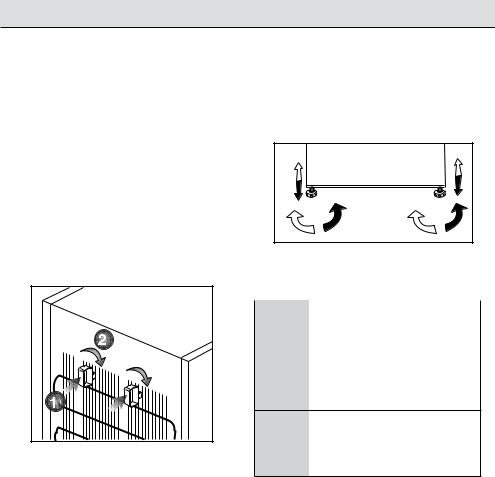
Installation
3.2. Installing the plastic wedges
Plastic wedges supplied with the product are used to create the distance for the air circulation between the product and the rear wall.
To install the wedges, remove the screws on the product and use the screws supplied together with the wedges.
Insert the 2 plastic wedges onto the rear ventilation cover as illustrated in the figure.
3.3. Adjusting the feet
If the product stands unbalanced after installation, adjust the feet on the front by rotating them to the right or left.
3.4. Electrical connection
A |
WARNING: Do not make |
connections via extension |
|
|
cables or multi-plugs. |
B |
WARNING: Damaged |
power cable must be |
|
replaced by the Authorized |
|
|
Service Agent. |
If two coolers are to be C installed side by side, there
should be at least 4 cm
distance between them. t Our company shall not be liable
for any damages that will arise when the product is used without grounding and electrical connection in accordance with the national regulations.
t Power cable plug must be within easy reach after installation.
t Do not extension cords or cordless multiple outlets between your product and the wall outlet.
|
10 /20 EN |
Refrigerator/User Manual |
|
|
|

4 Preparation
t For a freestanding appliance; ‘this refrigerating appliance is not intended to be used as a built-in appliance.
t Your refrigerator should be installed at least 30 cm away from heat sources such as hobs, ovens, central heater and stoves and at least 5 cm away from electrical ovens and should not be located under direct sunlight.
t The ambient temperature of the room where you install your refrigerator should at least be -15°C. Operating your refrigerator under colder conditions than this is not recommended.
t Please make sure that the interior of your refrigerator is cleaned thoroughly.
t If two refrigerators are to be installed side by side, there should be at least 2 cm distance between them.
t When you operate your refrigerator for the first time, please observe the following instructions during the initial six hours.
t The door should not be opened frequently.
t It must be operated empty without any food in it.
t Do not unplug your refrigerator. If a power failure occurs out of your control, please see the warnings in
the “Recommended solutions for the problems” section.
t Original packaging and foam materials should be kept for future transportations or moving.
t The baskets/drawers that are provided with the chill compartment
must always be in use for low energy consumption and for better storage conditions.
t Food contact with the temperature sensor in the freezer compartment may increase energy consumption of the appliance. Thus any contact with the sensor(s) must be avoided.
t In some models, the instrument panel automatically turns off 5 minutes after the door has closed. It will be reactivated when the door has opened or pressed on any key.
t Due to temperature change as a result of opening/closing the product door during operation, condensation on the door/body shelves and the glass containers is normal.
t Since hot and humid air will not directly penetrate into your product when the doors are not opened, your product will optimize itself in conditions sufficient to protect your food. Functions and components such as compressor, fan, heater, defrost, lighting, display and so on will operate according to the needs to consume minimum energy under these circumstances.
Refrigerator/User Manual |
11 / 20 EN |
|
|
|
|
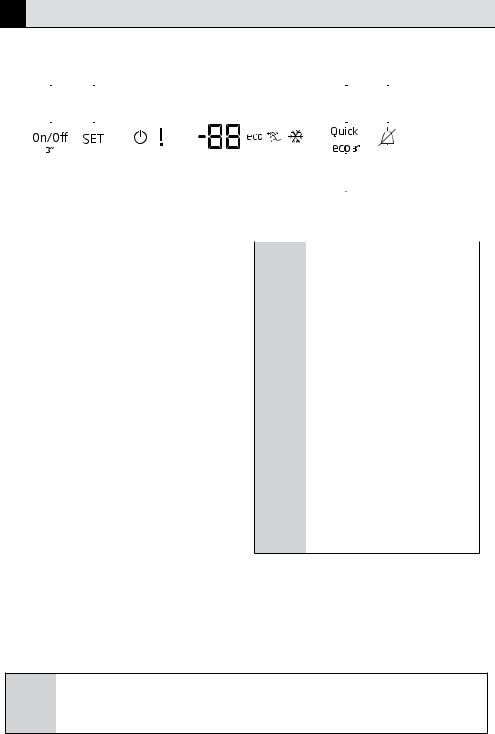
5 Operating the product
1 |
2 |
3 |
4 |
|||||
|
|
|
|
|
|
|
|
|
|
|
|
|
|
|
|
|
|
|
|
|
|
|
|
|
|
|
|
|
|
|
|
|
|
|
|
|
|
|
|
|
|
|
|
|
5
1.On/Off Indicator:
When the fridge is off, (On/Off) symbol is lit. All the other symbols are turned off.
2. Freezer compartment temperature setting button
Press this button to set the temperature of the freezer compartment to -18,-19,- 20,-21, -22, -23,-24, -18... respectively. Press this button to set the freezer compartment temperature to the desired value. (SET)
3. Quick freeze function button
Press this button to activate or deactivate the quick freeze function. When you activate the function, the freezer compartment will be cooled to a temperature lower than the set value. (Quick)To turn on or off the icematic, press and hold it for 3 seconds.
|
Use |
the |
quick |
freeze |
||
C function |
when |
you |
want |
|||
|
to |
quickly |
freeze |
the |
||
|
food |
placed |
in freezer |
|||
|
compartment. If |
you |
want |
|||
|
to freeze large |
amounts |
||||
|
of fresh food, activate this |
|||||
|
function before putting the |
|||||
|
food into the product. |
|
||||
C |
If you do not cancel it, Quick |
|||||
Freeze |
will |
cancel |
itself |
|||
|
automatically after 50 hours |
|||||
|
at the most or when the |
|||||
|
fridge compartment reaches |
|||||
|
to the required temperature. |
|||||
C |
This function is not recalled |
|||||
|
when power restores after a |
|||||
power failure.
Figures in this user manual are schematic and may not match the product C exactly. If the subject parts are not included in the product you have
purchased, then those parts are valid for other models.
|
12 /20 EN |
Refrigerator/User Manual |
|
|
|

Operating the product
4. Alarm off warning
In case of power failure/high temperature alarm, after checking the food located in the freezer compartment,
press the alarm off button (  ) to clear the warning.
) to clear the warning.
5. Eco fuzzy
Press and hold the eco fuzzy button for 1 seconds to activate the eco fuzzy function. The freezer will start to operate in the most economic mode at least 6 hours later and the economic usage indicator will be on. (eco3") Press and hold the eco fuzzy function button for 3 seconds to disable the eco fuzzy function. This indicator becomes on 6 hours later while the eco fuzzy function is on.
5.1. Ice Pack
Ice subsitute pack decelerates thawing of stored frozen food in case of blackout or malfunction. Placing the pack directly on top of the food will enable the longest storing period.
Ice substitute pack can also be used to keep food temporarily cold, e.g. in a cooler bag.
-Active”quıck freeze function” at least 24 hour before loading fresh food.
-Put 2 pcs ice packs ( if available ) inside the bottom drawer.
-Place fresh food on the shelves of 2 nd&3rd from the bottom.(maximum capacıty can be achieved by removing the drawers
Refrigerator/User Manual |
13 / 20 EN |
|
|
|
|

Operating the product 5.2. Freezing fresh food
t In order to preserve the quality of the food, it shall be frozen as quickly as possible when it is placed in the freezer compartment, use the fast freezing feature for this purpose.
t You may store the food longer in freezer compartment when you freeze them while they are fresh.
t Pack the food to be frozen and close the packing so that it would not allow entrance of air.
t Ensure that you pack your food before putting them in the freezer. Use freezer containers, foils and moisture-proof papers, plastic bags and other packing materials instead of traditional packing papers.
t Label each pack of food by adding the date before freezing. You may distinguish the freshness of each food pack in this way when you open your freezer each time. Store the food frozen before in the front side of compartment to ensure that they are used first.
C The freezer compartment defrosts automatically.
t Frozen food must be used immediately after they are thawed and they should not be re-frozen.
t Do not freeze too large quantities of food at one time.
|
14 /20 EN |
Refrigerator/User Manual |
|
|
|

Operating the product
Freezer |
Fridge |
Remarks |
|
Compartment |
compartment |
||
Setting |
Setting |
|
|
-18°C |
4°C |
This is the normal recommended setting. |
|
-20,-22 or -24°C |
4°C |
These settings are recommended when the |
|
ambient temperature exceeds 30°C. |
|||
|
|
||
|
|
Use when you wish to freeze your food in a short |
|
Quick Freeze |
4°C |
time. Your product will return to its previous |
|
|
|
mode when the process is over. |
|
|
|
Use these settings if you think that your fridge |
|
-18°C or colder |
2°C |
compartment is not cold enough because of the |
|
hot ambient conditions or frequent opening and |
|||
|
|
||
|
|
closing of the door. |
5.3. Recommendations for preserving the frozen food
Compartment shall be set to -18°C at least.
Put packages in the freezer as quickly as possible after purchase without allowing the to thaw.
Check whether the "Use By" and "Best Before" dates on the packaging are expired or not before freezing it.
Ensure that the package of the food is not damaged.
5.4. Deep-freeze information
According to IEC 62552 standards, the product shall freeze at least 4.5 kg of food at 32°C ambient temperature to -18°C or lower within 24 hours for every 100-litres of freezer volume.
It is possible to preserve the food for a long time only at -18°C or lower temperatures.
You can keep the freshness of food for many months (at -18°C or lower temperatures in the deep freeze).
Foods to be frozen should not be allowed to come in contact with the previously frozen items to prevent them from getting thawed partially.
Boil the vegetables and drain their water in order to store vegetables for a longer time as frozen. After draining their water, put them in air-proof packages and place them inside the freezer. Food such as bananas, tomatoes, lettuce, celery, boiled eggs, potatoes are not suitable for freezing. When these foods are frozen, only their nutritional value and taste shall be affected negatively. They shall not be spoiled so that they would create a risk for human health.
Refrigerator/User Manual |
15 / 20 EN |
|
|
|
|

Operating the product
5.5. Placing the food
Freezer |
Various frozen food |
|
such as meat, fish, |
||
compartment |
||
ice cream, vegetables |
||
shelves |
||
and etc. |
||
|
||
Refrigerator |
Food in pans, covered |
|
plates and closed |
||
compartment |
||
containers, eggs (in |
||
shelves |
||
closed container) |
||
|
||
Door shelves |
Small and packaged |
|
of fridge |
||
food or beverage |
||
compartment |
||
|
||
Crisper |
Vegetables and fruits |
|
|
Delicatessen |
|
Fresh zone |
(breakfast food, |
|
meat products that |
||
compartment |
||
shall be consumed in |
||
|
||
|
a short time) |
5.6. Freezing of Foodstuff
To activate fast freeze function, please turn the knob to MAX position. 50 hours after the fast freeze function was activated, the appliance with automaticly switch to normal function. If there’s no intend to freeze new fresh food, do not switch the knob to MAX setting. If the knob is left at the MAX position, since appliance is previously turned to normal running conditions; in order to activate the Quick Freeze Function again, please switch the knob out of MAX position and then switch it to MAX again. For the best possible freezing performance, the fresh food to be frozen should be introduced 24 hours after starting the quick freeze function.
5.7. Door open warning
(This feature is optional)
An audio warning signal will be given when the door of your product is left open for at least 1 minute. This warning will be muted when the door is closed or any of the display buttons (if any) are pressed.
Door open warning is given to user both visually and acoustically. If the warning continues for 10 minutes, interior lights will be turned off.
5.8. Changing the door opening direction
Door opening direction of your refrigerator can be changed according to the place you are using it.If this is neces - sary, please call your nearest Authorized Service.
Above description is a general expression.For information on changing the opening direction of the door, you must refer to the warning label located on the inner side of the door.
|
16 /20 EN |
Refrigerator/User Manual |
|
|
|

|
|
|
|
|
|||||
|
6 |
|
Maintenance and cleaning |
||||||
|
Cleaning your fridge at regular intervals |
t Never use cleaning agents or water |
|||||||
|
will extend the service life of the pro- |
|
that contain chlorine to clean the |
||||||
|
duct. |
|
|
|
outer surfaces and chromium coated |
||||
|
B WARNING: |
|
parts of the product. Chlorine causes |
||||||
|
|
corrosion on such metal surfaces. |
|||||||
|
Unplug the product before cleaning it. |
|
6.1 Avoiding bad odours |
||||||
|
t Never use gasoline, benzene or |
|
t Materials that may cause odour |
||||||
|
|
similar substances for cleaning |
|
are not used in the production of |
|||||
|
|
purposes. |
|
our refrigerators. However, due |
|||||
|
t Never use any sharp and abrasive |
|
to inappropriate food preserving |
||||||
|
|
tools, soap, household cleaners, |
|
conditions and not cleaning the inner |
|||||
|
|
detergent and wax polish for |
|
surface of the refrigerator as required |
|||||
|
|
cleaning. |
|
can bring forth the problem of odour. |
|||||
|
t For non-No Frost products, |
|
Pay attention to following to avoid |
||||||
|
|
water drops and frosting up to a |
|
this problem: |
|||||
|
|
fingerbreadth occur on the rear wall |
t Keeping the refrigerator clean is |
||||||
|
|
of the Fridge compartment. Do not |
|
important. Food residuals, stains, etc. |
|||||
|
|
clean it; never apply oil or similar |
|
can cause odour. Therefore, clean |
|||||
|
|
agents on it. |
|
the refrigerator with bi-carbonate |
|||||
|
t Only use slightly damp microfiber |
|
dissolved in water every few months. |
||||||
|
|
cloths to clean the outer surface of |
|
Never use detergents or soap. |
|||||
|
|
the product. Sponges and other types |
t Keep the food in closed containers. |
||||||
|
|
of cleaning cloths may scratch the |
|
Microorganisms spreading out from |
|||||
|
|
surface |
|
uncovered containers can cause |
|||||
|
t Dissolve one teaspoon of bi- |
|
unpleasant odours. |
||||||
|
|
carbonate in half litre of water. Soak |
t Never keep the food that have passed |
||||||
|
|
a cloth with the solution and wrung |
|
best before dates and spoiled in the |
|||||
|
|
it thoroughly. Wipe the interior of the |
refrigerator. |
||||||
|
|
refrigerator with this cloth and the |
|
6.2 Protecting the plas- |
|||||
|
t |
dry thoroughly. |
|
tic surfaces |
|||||
|
Make sure that no water enters the |
|
Do not put liquid oils or oil-cooked meals |
||||||
|
|
lamp housing and other electrical |
|
||||||
|
|
|
in your refrigerator in unsealed contai- |
||||||
|
|
items. |
|
|
|
||||
|
|
|
|
|
ners as they damage the plastic surfaces |
||||
|
t |
If you will not use the refrigerator |
|
||||||
|
|
of the refrigerator. If oil is spilled or sme- |
|||||||
|
|
for a long period of time, unplug it, |
|
||||||
|
|
|
ared onto the plastic surfaces, clean and |
||||||
|
|
remove all food inside, clean it and |
|
||||||
|
|
|
rinse the relevant part of the surface at |
||||||
|
|
leave the door ajar. |
|
||||||
|
|
|
once with warm water. |
||||||
|
t |
Check regularly that the door gaskets |
|||||||
|
|
|
|
||||||
|
|
are clean. If not, clean them. |
|
|
|
|
|||
|
t |
To remove door and body shelves, |
|
|
|
|
|||
|
|
remove all of its contents. |
|
|
|
|
|||
|
t |
Remove the door shelves by pulling |
|
|
|
|
|||
|
|
them up. After cleaning, slide them |
|
|
|
|
|||
|
|
from top to bottom to install. |
|
|
|
|
|
||
Refrigerator/User Manual |
|
17 / 20 EN |
|
|
|||||
|
|
|
|
|
|
|
|
|
|

7 Troubleshooting
Check this list before contacting the service. Doing so will save you time and money. This list includes frequent
complaints that are not related to faulty workmanship or materials. Certain features mentioned herein may not apply to your product.
The refrigerator is not working.
t The power plug is not fully settled.
>>> Plug it in to settle completely into the socket.
t The fuse connected to the socket powering the product or the main fuse is blown. >>> Check the fuses.
Condensation on the side wall of the cooler compartment (MULTI ZONE, COOL, CONTROL and FLEXI ZONE).
t The door is opened too frequently
>>> Take care not to open the product’s door too frequently.
t The environment is too humid. >>>
Do not install the product in humid environments.
t Foods containing liquids are kept in unsealed holders. >>> Keep the foods containing liquids in sealed holders.
t The product’s door is left open. >>>
Do not keep the product’s door open for long periods.
t The thermostat is set to too low temperature. >>> Set the thermostat to appropriate temperature.
Compressor is not working.
t In case of sudden power failure or pulling the power plug off and putting back on, the gas pressure in the product’s cooling system is not balanced, which triggers the compressor thermic safeguard. The product will restart after approximately 6 minutes. If the
product does not restart after this period, contact the service.
t Defrosting is active. >>> This is normal for a fully-automatic
defrosting product. The defrosting is carried out periodically.
t The product is not plugged in. >>>
Make sure the power cord is plugged in.
t The temperature setting is incorrect.
>>> Select the appropriate temperature setting.
t The power is out. >>> The product will continue to operate normally once the power is restored.
The refrigerator’s operating noise is increasing while in use.
t The product’s operating performance may vary depending on the ambient temperature variations. This is normal and not a malfunction.
The refrigerator runs too often or for too long.
t The new product may be larger than the previous one. Larger products will run for longer periods.
t The room temperature may be high.
>>> The product will normally run for long periods in higher room temperature.
t The product may have been recently plugged in or a new food item is placed inside. >>> The product
will take longer to reach the set temperature when recently plugged in or a new food item is placed inside. This is normal.
t Large quantities of hot food may have been recently placed into the product.
>>> Do not place hot food into the product.
t The doors were opened frequently or kept open for long periods. >>> The warm air moving inside will cause the product to run longer. Do not open the doors too frequently.
|
18 /20 EN |
Refrigerator/User Manual |
|
|
|

Troubleshooting
t The freezer or cooler door may be ajar. >>> Check that the doors are fully closed.
t The product may be set to temperature too low. >>> Set the temperature to a higher degree and wait for the product to reach the adjusted temperature.
t The cooler or freezer door washer may be dirty, worn out, broken or not properly settled. >>> Clean or replace the washer. Damaged / torn
door washer will cause the product to run for longer periods to preserve the current temperature.
The freezer temperature is very low, but the cooler temperature is adequate.
t The freezer compartment temperature is set to a very low degree. >>> Set the freezer compartment temperature to a higher degree and check again.
The cooler temperature is very low, but the freezer temperature is adequate.
t The cooler compartment temperature is set to a very low degree. >>>
Set the freezer compartment temperature to a higher degree and check again.
The food items kept in cooler compartment drawers are frozen.
t The cooler compartment temperature is set to a very low degree. >>>
Set the freezer compartment temperature to a higher degree and check again.
The temperature in the cooler or the freezer is too high.
t The cooler compartment temperature is set to a very high degree. >>>
Temperature setting of the cooler compartment has an effect on
the temperature in the freezer compartment. Wait until the temperature of relevant parts reach the sufficient level by changing the temperature of cooler or freezer compartments.
t The doors were opened frequently or kept open for long periods. >>> Do not open the doors too frequently.
t The door may be ajar. >>> Fully close the door.
t The product may have been recently plugged in or a new food item is placed inside. >>> This is normal. The product will take longer to reach the set temperature when recently plugged in or a new food item is placed inside.
t Large quantities of hot food may have been recently placed into the product.
>>> Do not place hot food into the product.
Shaking or noise.
t The ground is not level or durable.
>>> If the product is shaking when moved slowly, adjust the stands to balance the product. Also make sure the ground is sufficiently durable to bear the product.
t Any items placed on the product may cause noise. >>> Remove any items placed on the product.
The product is making noise of liquid flowing, spraying etc.
t The product’s operating principles involve liquid and gas flows. >>> This is normal and not a malfunction.
There is sound of wind blowing coming from the product.
t The product uses a fan for the cooling process. This is normal and not a malfunction.
Refrigerator/User Manual |
19 / 20 EN |
|
|
|
|

Troubleshooting
There is condensation on the product’s internal walls.
t Hot or humid weather will increase icing and condensation. This is normal and not a malfunction.
t The doors were opened frequently or kept open for long periods. >>> Do not open the doors too frequently; if open, close the door.
t The door may be ajar. >>> Fully close the door.
There is condensation on the product’s exterior or between the doors.
t The ambient weather may be humid, this is quite normal in humid weather.
>>> The condensation will dissipate when the humidity is reduced.
The interior smells bad.
t The product is not cleaned regularly.
>>> Clean the interior regularly using sponge, warm water and carbonated water.
t Certain holders and packaging materials may cause odour. >>>
Use holders and packaging materials without free of odour.
t The foods were placed in unsealed holders. >>> Keep the foods in sealed holders. Micro-organisms may spread out of unsealed food items and cause malodour. Remove any expired or spoilt foods from the product.
The door is not closing.
t Food packages may be blocking the door. >>> Relocate any items blocking the doors.
t The product is not standing in full upright position on the ground. >>>
Adjust the stands to balance the product.
t The ground is not level or durable.
>>> Make sure the ground is level and sufficiently durable to bear the product.
The vegetable bin is jammed.
t The food items may be in contact with the upper section of the drawer.
>>> Reorganize the food items in the drawer.
If The Surface Of The Product Is Hot. t High temperatures may be observed
between the two doors, on the side panels and at the rear grill while the product is operating. This is normal and does not require service maintenance!Be careful when touching these areas.
A WARNING:
If the problem persists after following the instructions in this section, contact your vendor or an Authorised Service. Do not try to repair the product.
|
20 /20 EN |
Refrigerator/User Manual |
|
|
|
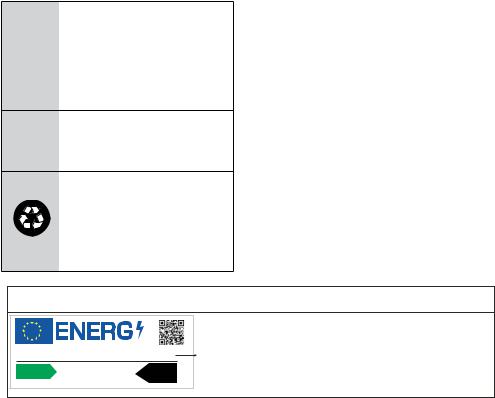
Sehr geehrter Kunde,
Wir möchten Ihnen eine optimale Effizienz Ihres Produkts bieten, welches in modernen Betrieben mit akribischen Qualitätskontrollen hergestellt wurde.
Hierzu bitten wir Sie die Bedienungsanleitung vollständig und gründlich durchzulesen und das Handbuch als Referenzquelle aufzubewahren. Wenn Sie das Produkt wiederum an eine andere Person weitergeben, geben Sie auch dieses Handbuch zusammen mit dem Produkt weiter.
Das Benutzerhandbuch gewährleistet die schnelle und sichere Anwendung des Produkts.
t Vor der Installation und Anwendung des Produkts, lesen Sie bitte diese Bedienungsanleitung sorgfältig durch.
t Beachten Sie auf alle Fälle die Anleitung im Zusammenhang mit der Sicherheit.
t Da Sie diese Bedienungsanleitung auch in der Zukunft benötigen werden, sollte es leicht zugänglich aufbewahrt werden.
t Lesen Sie auch die, mit dem Produkt mitgelieferten, sonstigen Belege durch.
Beachten Sie, dass diese Anleitung für mehrere Produktmodelle anwendbar ist. Differenzen zwischen den Modellen sind eindeutig aufgeführt.
Symbole und Erläuterungen
In dieser Bedienungsanleitung befinden sich folgende Symbole:
C |
Wichtige Informationen |
oder hilfreiche Tipps. |
|
|
|
A |
Risiken für Gesundheit und |
Produkt. |
B Stromschlagrisiko.
Verpackung des Produktes, produziert aus wiederverwertbarem Materialien entsprechend der nationalen Umweltschutzgesetze.
C ANGABEN |
|
|
|
|
|
|
Die Modellinformationen, wie sie in der Produktdatenbank |
|
|
|
gespeichert sind, können durch Eingabe der folgenden Web- |
|
|
(*) |
site und Suche nach Ihrer Modellkennung (*) auf dem Ener- |
SUPPLIER’S NAME |
MODEL IDENTIFIER |
gieetikett erreicht werden. |
|
A |
A |
|
https://eprel.ec.europa.eu/ |
|
|

1 Wichtige |
|
Sicherheitshinweise |
3 |
2 Ihr Kühlschrank/ |
|
Gefrierschrank |
9 |
3 Installation |
10 |
Wenn Sie den Kühlschrank versetzen |
|
möchten: ........................................................ |
10 |
Vor dem Einschalten ................................. |
10 |
Elektrischer Anschluss............................. |
10 |
Verpackungsmaterialien entsorgen.... |
11 |
Altgeräte entsorgen................................... |
11 |
Aufstellung und Installation ................... |
11 |
4 Vorbereitung |
12 |
5 Nutzung des Kühlschrank/ Gefrierschranks 13
Doppeltes Kühlsystem ............................. |
14 |
Frische Lebensmittel tiefkühlen.......... |
14 |
Empfehlungen zur Konservierung |
|
gefrorener Lebensmittel......................... |
16 |
Einfrieren von Lebensmitteln ............... |
16 |
Lebensmittel platzieren .......................... |
17 |
Hinweise zum Tiefkühlen ....................... |
17 |
Tür-offen-Warnung................................... |
17 |
Wechseln des Türanschlags .................. |
17 |
6 Pflege und Reinigung |
18 |
7 Problemlösung |
19 |
|
2 / 23 DE |
Kühlschrank/Bedienungsanleitung |
|
|
|

1 Wichtige Sicherheitshinweise
Bitte lesen Sie die folgenden Hinweise aufmerksam durch. Bei Nichtbeachtung dieser Angaben kann es zu Verletzungen und Sachschäden kommen. In diesem Fall erlöschen auch sämtliche Garantieund sonstigen Ansprüche.
Originalersatzteile stehen für einen Zeitraum von 10 Jahre beginnend mit dem Kaufdatum zur Verfügung.
-In Personalküchen in Geschäften, Büros und anderen Arbeitsumgebungen;
-In Bauernhöfen, Hotels, Motels und anderen Unterkünften, für den Gebrauch der Kunden;
-Umgebungen mit Übernachtung und Frühstück;
-Bei Catering und ähnlichen Non- Retail-Anwendungen.
|
Bestimmungsgemäßer Einsatz |
Allgemeine Hinweise zu Ihrer |
|||||
|
|
|
|
|
|
Sicherheit |
|
|
|
ACHTUNG: |
|
|
|
||
|
|
Stellen Sie sicher, dass |
|
t Wenn Sie das Gerät entsorgen |
|||
|
|
wenn das Gerät in seinem |
|
möchten, wenden Sie sich am besten |
|||
|
A Gehäuse oder platziert ist, die |
|
an den autorisierten Kundendienst. |
||||
|
|
Entlüftungsöffnungen nicht |
|
Hier erhalten Sie notwendige |
|||
|
|
blockiert werden. |
|
|
|
Informationen und erfahren, welche |
|
|
|
|
|
|
|
Stellen für die Entsorgung zuständig |
|
|
|
ACHTUNG: |
|
|
|
||
|
|
Um den Auftauvorgang zu |
|
sind. |
|||
|
|
beschleunigen, keine anderen |
|
t Bei Problemen und Fragen zum Gerät |
|||
|
A mechanischen Geräte oder |
|
wenden Sie sich grundsätzlich an den |
||||
|
|
Geräte verwenden, die nicht |
|
autorisierten Kundendienst. Ziehen |
|||
|
|
vom Hersteller empfohlen sind. |
|
Sie keine Dritten zu Rate, versuchen |
|||
|
|
|
|
|
|
Sie nichts in Eigenregie, ohne den |
|
|
A |
ACHTUNG: |
|
|
|
||
|
Dem Kühlmittelkreislauf keine |
|
autorisierten Kundendienst davon in |
||||
|
|
Schäden zufügen. |
|
|
|
Kenntnis zu setzen. |
|
|
|
|
|
|
|
t Bei Geräten mit Tiefkühlbereich: Der |
|
|
|
ACHTUNG: |
|
|
|
||
|
|
|
|
|
Verzehr von Speiseeis und Eiswürfeln |
||
|
|
In den ebensmittelaufbe- |
|
unmittelbar nach der Entnahme aus |
|||
|
|
wahrungsfächern keine |
|
dem Tiefkühlbereich ist nicht ratsam. |
|||
|
A elektrischen Geräte |
|
(Dies kann zu Erfrierungen führen.) |
||||
|
|
verwenden,die nicht vom |
|
t Bei Geräten mit Tiefkühlbereich: |
|||
|
|
Hersteller empfohlen sind. |
|
||||
|
|
|
Bewahren Sie Getränke in |
||||
|
|
|
|
|
|
Flaschen sowie Dosen niemals im |
|
|
|
WARNUNG: |
|
|
|
||
|
|
Lagern Sie keinerlei explosiven |
|
Tiefkühlbereich auf. Diese platzen. |
|||
|
|
|
t Berühren Sie gefrorene Lebensmittel |
||||
|
|
Substanzen (dazu zählen auch |
|
||||
|
A Sprühdosen mit |
brennbarem |
|
nicht mit der Hand; sie können |
|||
|
|
Treibmittel) im Gerät. |
|
festfrieren. |
|||
|
|
|
|
|
|
t Trennen Sie Ihren Kühlschrank vor dem |
|
|
Dieses Gerät ist für die private Nutzung |
Reinigen oder Abtauen vom Stromnetz. |
|||||
oder für den Gebrauch bei folgenden |
|
|
|||||
ähnlichen Anwendungen |
konzipiert |
|
|
||||
wurden |
|
|
|
|
|
|
|
|
|
|
|
|
|
||
Kühlschrank/Bedienungsanleitung |
|
3 / 23 DE |
|
||||
|
|
|
|
|
|
|
|

Sicherheitsund Umweltschutzanweisungen
t Verwenden Sie niemals Dampfoder Sprühreiniger zum Reinigen und Abtauen Ihres Kühlschranks. Die Dämpfe oder Nebel können in Kontakt mit stromführenden Teilen geraten und Kurzschlüsse oder Stromschläge auslösen.
t Missbrauchen Sie niemals Teile Ihres Kühlschranks (z. B. Tür) als Befestigungen oder Kletterhilfen.
t Nutzen Sie keine elektrischen Geräte innerhalb des Kühlschranks.
t Achten Sie darauf, den Kühlkreislauf keinesfalls mit Bohroder Schneidwerkzeugen zu beschädigen. Das Kühlmittel kann herausspritzen, wenn die Gaskanäle des Verdunsters, Rohrund Schlauchleitungen oder Oberflächenversiegelungen beschädigt werden. Dies kann zu Hautreizungen und Augenverletzungen führen.
t Decken Sie keinerlei Belüftungsöffnungen des Kühlschranks ab.
t Elektrische Geräte dürfen nur von autorisierten Fachkräften repariert werden. Reparaturen durch weniger kompetente Personen können erhebliche Gefährdungen des Anwenders verursachen.
t Sollten Fehler oder Probleme während der Wartung oder Reparaturarbeiten auftreten, so trennen Sie den Kühlschrank von der Stromversorgung, indem Sie die entsprechende Sicherung abschalten oder den Netzstecker ziehen.
t Ziehen Sie niemals am Netzkabel – ziehen Sie direkt am Stecker.
t Achten Sie darauf, hochprozentige Getränke stehend und mit fest verschlossenem Deckel zu lagern.
t Bewahren Sie niemals Sprühdosen mit brennbaren und explosiven Substanzen im Kühlschrank auf.
t Nutzen Sie keine mechanischen oder anderen Hilfsmittel, um das Gerät abzutauen – es sei denn, solche Hilfsmittel werden ausdrücklich vom Hersteller empfohlen.
t Dieses Produkt darf nicht von Personen (einschließlich Kindern) mit eingeschränkten physischen, sensorischen oder geistigen Fähigkeiten bedient werden, sofern
sie nicht durch eine Person, die für ihre Sicherheit verantwortlich ist, in der Bedienung des Produktes angeleitet werden.
t Nehmen Sie einen beschädigten Kühlschrank nicht in Betrieb. Wenden Sie sich bei jeglichen Zweifeln an einen Kundendienstmitarbeiter.
t Die elektrische Sicherheit des Gerätes ist nur dann gewährleistet, wenn
das hausinterne Erdungssystem den zutreffenden Normen entspricht.
t Setzen Sie das Gerät keinem Regen, Schnee, direktem Sonnenlicht oder Wind aus; dies kann die elektrische Sicherheit gefährden.
t Wenden Sie sich zur Vermeidung von Gefahren an den autorisierten Kundendienst, falls das Netzkabel beschädigt ist.
t Stecken Sie während der Installation niemals den Netzstecker ein. Andernfalls kann es zu schweren bis tödlichen Verletzungen kommen.
t Dieser Kühlschrank dient nur der Aufbewahrung von Lebensmitteln. Für andere Zwecke sollte er nicht verwendet werden.
|
4 / 23 DE |
Kühlschrank/Bedienungsanleitung |
|
|
|
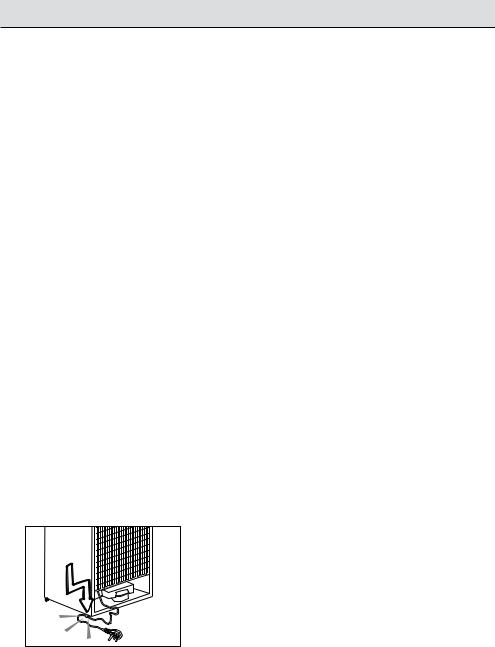
Sicherheitsund Umweltschutzanweisungen
t Das Etikett mit den technischen Daten befindet sich an der linken Innenwand des Kühlschranks.
t Schließen Sie Ihren Kühlschrank niemals an energiesparende Systeme an; dies kann den Kühlschrank beschädigen.
t Falls sich ein blaues Licht am Kühlschrank befindet, blicken Sie nicht längere Zeit mit bloßem Augen oder optischen Werkzeugen hinein.
t Bei manuell gesteuerten Kühlschränken warten Sie mindestens 5 Minuten, bevor Sie den Kühlschrank nach einem Stromausfall wieder einschalten.
t Falls Sie das Gerät an einen anderen Besitzer weitergeben, vergessen Sie nicht, die Bedienungsanleitung ebenfalls auszuhändigen.
t Achten Sie darauf, dass das Netzkabel beim Transport des Kühlschranks nicht beschädigt wird. Übermäßiges Biegen des Kabels birgt Brandgefahr. Platzieren Sie keine schweren Gegenstände auf dem Netzkabel.
t Berühren Sie den Netzstecker niemals mit feuchten oder gar nassen Händen.
t Achten Sie beim Aufstellen des Gerätes darauf, dass das Netzkabel nicht eingeklemmt oder anderweitig beschädigt wird.
t Platzieren Sie nicht mehrere Mehrfachsteckdosen oder Netzteile hinter dem Gerät.Schließen Sie den Kühlschrank nicht an lose Steckdosen an.
t Kinder im Alter von 3 bis 8 Jahren dürfen Kühlgeräte einund ausräumen.
t Vermeiden Sie durch Einhaltung der folgenden Anweisungen Lebensmittelkontamination:
t Durch langes Öffnen der Tür kann die Temperatur in den Fächern des Gerätes drastisch ansteigen.
t Reinigen Sie die Oberflächen, die mit Lebensmitteln in Berührung kommen, sowie zugängliche Ableitungssysteme regelmäßig.
t Reinigen Sie Wassertanks, wenn diese 48 Stunden lang nicht benutzt wurden; spülen Sie das an die Wasserversorgung angeschlossene Wassersystem durch, falls 5 Tage lang kein Wasser entnommen wurde.
t Bewahren Sie rohes Fleisch und Fisch in geeigneten Behältern im Kühlschrank auf, damit diese nicht mit anderen Lebensmitteln in Berührung kommen.
t Zwei-Sterne-Gefrierfächer eignen sich zur Aufbewahrung von Tiefkühlkost, zur Lagerung oder Herstellung von Speiseeis und zur Herstellung von Eiswürfeln.
t Ein-, Zweiund Drei-Sterne-Fächer eignen sich nicht zum Einfrieren frischer Lebensmittel.
t Falls das Kühlgerät lange Zeit leer bleibt, sollten Sie es abschalten, abtauen, reinigen, trocknen und die
t Tür geöffnet lassen, damit sich kein Schimmel im Gerät bildet.
Kühlschrank/Bedienungsanleitung |
5 / 23 DE |
|
|
|
|
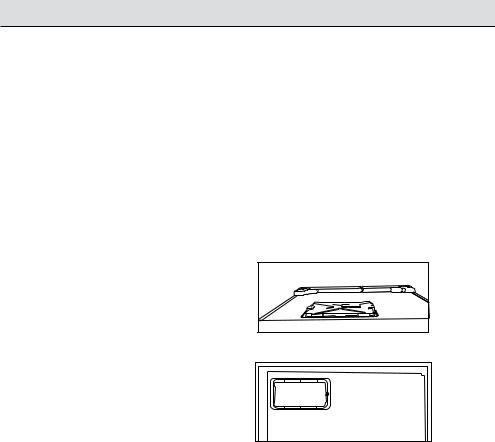
Sicherheitsund Umweltschutzanweisungen
t Sprühen Sie aus Sicherheitsgründen niemals Wasser auf die Innenund Außenflächen des Gerätes.
t Sprühen Sie keine Substanzen mit brennbaren Gasen, wie z. B. Propangas, in die Nähe des Kühlschranks; andernfalls bestehen Brandund Explosionsgefahr.
t Stellen Sie keine mit Wasser gefüllten Gegenstände auf den Kühlschrank; dies birgt Brandund Stromschlaggefahr.
t Überladen Sie das Gerät nicht mit Lebensmitteln. Wenn das Gerät überladen ist, können beim Öffnen der Kühlschranktür Lebensmittel herausfallen und Verletzungen verursachen.
t Stellen Sie keinesfalls Gegenstände auf den Kühlschrank; sie könnten beim Öffnen oder Schließen der Kühlschranktür herunterfallen.
t Materialien wie beispielsweise Impfstoffe, wärmeempfindliche Arznei, wissenschaftliche Proben usw. sollten nicht im Kühlschrank aufbewahrt werden, da sie bei exakt festgelegten Temperaturen gelagert werden müssen.
t Trennen Sie den Kühlschrank vom Stromnetz, wenn er längere Zeit nicht benutzt wird. Ein mögliches Problem im Netzkabel kann einen Brand auslösen.
t Wenn die höhenverstellbaren Füße nicht sicher auf dem Boden stehen, kann sich der Kühlschrank bewegen. Die angemessene Sicherung der höhenverstellbaren Füße am Boden kann eine Bewegung des Kühlschranks verhindern.
t Halten Sie den Kühlschrank beim Tragen nicht am Türgriff. Andernfalls könnte er abbrechen.
t Wenn Sie Ihr Produkt neben einem anderen Kühloder Gefrierschrank aufstellen möchten, sollte der Abstand zwischen beiden Geräten mindestens 8 cm betragen. Andernfalls können die benachbarten Seitenwände feucht werden.
t Benutzen Sie das Gerät niemals, wenn die sich auf der Oberseite bzw. auf
der Rückseite befindlichen Bereiche mit den elektronischen Leitern im Inneren geöffnet sind (Abdeckung der
elektronischen Leiterplatten) (1).
1 |
1
Bei Geräten mit :Wasserspender
t Der Druck für die Kaltwasserzufuhr sollte maximal 90 psi (620 kPa) betragen. Wenn der Wasserdruck in Ihrem Haushalt 80 psi (550 kPa) übersteigt, verwenden Sie bitte ein Druckbegrenzungsventil in Ihrem Leitungssystems. Sollten Sie nicht wissen, wie der Wasserdruck
gemessen wird, ziehen Sie bitte einen Fachinstallateur hinzu.
t Sollte für Ihr Leitungssystem das Risiko eines Wasserschlags (Druckstoß) bestehen, verwenden Sie stets eine geeignete Druckstoßsicherung.
|
6 / 23 DE |
Kühlschrank/Bedienungsanleitung |
|
|
|

Sicherheitsund Umweltschutzanweisungen
Wenden Sie sich bitte an einen Fachinstallateur, falls Sie sich über die Wasserschlaggefährdung in Ihrem Leitungssystem nicht sicher sein sollten.
t Nutzen Sie niemals die Warmwasserzufuhr für den Einbau. Treffen Sie geeignete Vorsichtsmaßnahmen zum Schutz der Leitungen gegen mögliches
Einfrieren. Die für den Betrieb zulässige Wassertemperatur liegt im Bereich
von mindestens 0,6°C (33°F) bis hin zu maximal 38°C (100°F ).
t Nur Trinkwasser verwenden.
Kinder – Sicherheit
t Bei abschließbaren Türen bewahren Sie den Schlüssel außerhalb der Reichweite von Kindern auf.
t Achten Sie darauf, dass Kinder nicht mit dem Produkt spielen.
Erfüllung von WEEE-Vorgaben :zur Entsorgung von Altgeräten
Dieses Produkt erfüllt die Vorgaben der EU-WEEE-
Direktive (2012/19/EU).
DasProduktwurdemiteinem K l a s s i f i z i e r u n g s s y m b o l für elektrische und elektronische Altgeräte
(WEEE) gekennzeichnet.
Dieses Gerät wurde aus hochwertigen Materialien hergestellt, die wiederverwendet und recycelt werden können. Entsorgen Sie das Gerät am Ende seiner Einsatzzeit nicht mit dem regulären Hausmüll; geben Sie es stattdessen bei einer Sammelstelle zur Wiederverwertung von elektrischen
und elektronischen Altgeräten ab. Ihre Stadtverwaltung informiert Sie gerne über geeignete Sammelstellen in Ihrer Nähe.
Hinweise zur Verpackung
Die Verpackungsmaterialien des Gerätes wurden gemäß nationalen Umweltschutzbestimmungen aus recyclingfähigen Materialien hergestellt. Entsorgen Sie Verpackungsmaterialien nicht mit dem regulären Hausmüll oder anderen Abfällen. Bringen Sie Verpackungsmaterialien zu geeigneten Sammelstellen; Ihre Stadtverwaltung berät Sie gern.
Nicht vergessen!
Recycelte Materialien leisten einen wichtigen Beitrag zu einer schönen und gesunden Umwelt.
Wenn Sie zur Wiederverwertung von Verpackungsmaterialien beitragen möchten, informieren Sie sich bei Ihren Umweltschutzbehörden oder der Stadtverwaltung, wo entsprechende Sammelstellen zu finden sind.
HC-Warnung
Falls das Kühlsystem Ihres Produktes R600a enthält:
Dieses Gas ist leicht entflammbar. Achten Sie also darauf, Kühlkreislauf und Leitungen während Betrieb und Transport nicht zu beschädigen. Bei Beschädigungen halten Sie das Produkt von potenziellen Zündquellen (z. B. offenen Flammen) fern und sorgen für eine gute Belüftung des Raumes, in dem das Gerät aufgestellt wurde.
Ignorieren Sie diese Warnung, falls das Kühlsystem Ihres Produktes R134a enthält.
Kühlschrank/Bedienungsanleitung |
7 / 23 DE |
|
|
|
|
